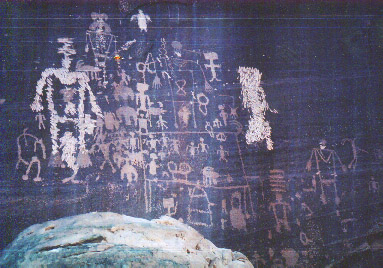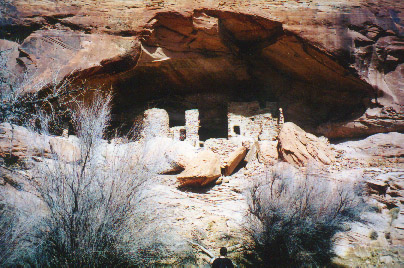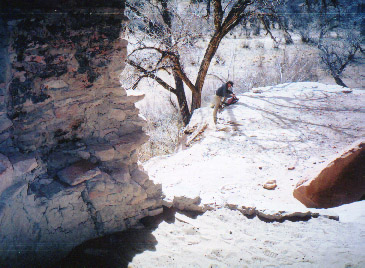We went back to the raft using the old Mormon Trading Post ruins as a landmark and started down the river. We had begun the trip just drifting with the current but realized that we needed to row some to gain a little time for ruin exploration. The wind began to increase and we realized that we had to row in order to make any headway at all. Norm was the strongest rower and his maximum effort barely moved us downstream. I got out and towed the raft a few times. Colin worked to keep the raft from hitting the shore. When the water got too deep along the bank, Norm resumed rowing. I also tried using our extra oar as a rudder, paddle or pole but nothing was really successful.
 We had a campsite marked on our map above Chinle Wash on the south bank. But as we made our way down using these various techniques, we couldn't spot it. Cattle had made trails down to the river and we couldn't tell which one led to the campsite. We decided that the campsite on the north bank was our best bet. We didn't want to go downstream of Chinle Wash because we wanted to hike up into it the next day. We were calling the wind a Sirocco at this point. Sand was clogging up our nostrils and reducing the visibility. The bottoms of sandstone butts were disappearing in a fog of sand. The sand was drifting and forming wind shadows around tress and rocks. It reminded me of blizzards I had experienced in Maine.
We had a campsite marked on our map above Chinle Wash on the south bank. But as we made our way down using these various techniques, we couldn't spot it. Cattle had made trails down to the river and we couldn't tell which one led to the campsite. We decided that the campsite on the north bank was our best bet. We didn't want to go downstream of Chinle Wash because we wanted to hike up into it the next day. We were calling the wind a Sirocco at this point. Sand was clogging up our nostrils and reducing the visibility. The bottoms of sandstone butts were disappearing in a fog of sand. The sand was drifting and forming wind shadows around tress and rocks. It reminded me of blizzards I had experienced in Maine.
 We found a slight rise of sand topped by a dead log and some bushes and pitched the tents on the lee side with the narrow end pointing upwind. We retreated into our tents and collapsed onto our bags. The wind continued to build in intensity and sand would rush into any opening. Even with all windows and doors zippered tightly shut a dusting of sand formed on everything. I had experienced a sand storm in Rajasthan, India and knew that it was impossible to escape from the sand and just tried to accept it.
We found a slight rise of sand topped by a dead log and some bushes and pitched the tents on the lee side with the narrow end pointing upwind. We retreated into our tents and collapsed onto our bags. The wind continued to build in intensity and sand would rush into any opening. Even with all windows and doors zippered tightly shut a dusting of sand formed on everything. I had experienced a sand storm in Rajasthan, India and knew that it was impossible to escape from the sand and just tried to accept it.


